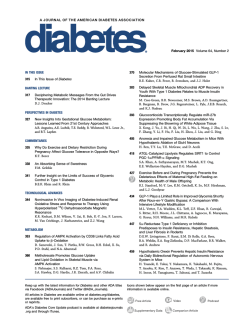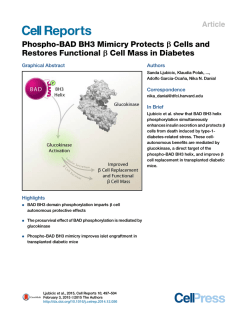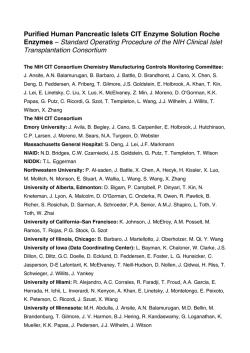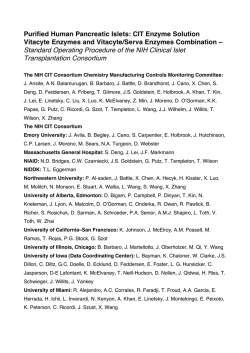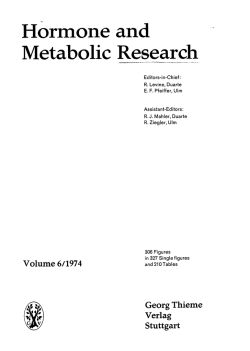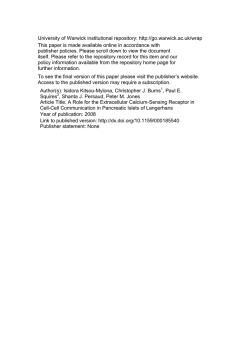
Islet Cell Transplant Surgery - MUSC Digestive Disease Center
Islet Cell Transplant Surgery What are islet cells? Islet cells (pronounced "EYE-let") are actually clusters (or groups) of cells within the pancreas that produce hormones. It is estimated that there are approximately one million of these clusters found in a healthy, adult pancreas, with each cluster containing between 3,000-4,000 cells. These islets make up only one to two percent of the entire pancreas. ADDITIONAL INFORMATION F o r mo re i nf o rmat i o n c o nc e rni ng M U S C ' s Is l e t C e l l Trans p l ant p ro g ram, p l e as e e mai l Be t s y S h u f o rd , Is l e t C e l l Trans p l ant C o o rd i nat o r, o r c al l h e r at ( 8 4 3) 8 7 6- 04 20. An islet contains many different types of cells that work in harmony to help regulate the blood sugar, or glucose, level in a person's body. Beta cells, for example, make the hormone insulin, which lowers the body's glucose (sugar) level. What is islet cell autotransplantation? An islet cell autotransplantation, also referred to as an autologous islet cell transplant, is the infusion of a patient's own pancreatic islet cells into the portal vein of the liver. The islet cells then become lodged in blood vessels of the liver where they become active and begin producing insulin. Because the body recognizes these islet cells as its own, there is absolutely no rejection of these cells by the patient's body. As a result, there will not be any need for drugs to prevent rejection like there would be with someone who has had an organ transplanted from another person. The technical term for this procedure is autologous The technical term for this procedure is autologous pancreatic islet cell transplantation. In this context, 'autologous' means cells that are removed from a patient's own body. In contrast, the same procedure using islet cells procedure is autologous pancreatic islet cell transplan tation … cells that are removed from a patient's own body. own body. In contrast, the same procedure using islet cells from another person is referred to as an allotransplantation, or 'allologous', but is no longer offered largely due to the high rate of rejection by the recipient's body. In select patients with debilitating pain from chronic pancreatitis, complete removal of the pancreas can offer significant pain relief. However, the resulting and unavoidable severe diabetes that will occur (along with potentially life threatening episodes of low and high blood sugars) has, in the past, precluded the recommendation of removing the total pancreas. With islet cell autotransplantation, however, we are able to preserve the pancreas immediately after removal, isolate out the insulin producing islet cells, and then return them to the patient via infusion into the liver. The optimal patients are those with pain secondary to chronic pancreatitis having failed all medical and other surgical management. Patients with hereditary pancreatitis are particularly to benefit given their likelihood of progressive disease and pancreatic failure as well as their risk for cancer. Surgery is usually reserved for people with chronic pancreatitis who have pain that does not respond to other treatments. A total pancreatectomy, which involves the complete removal of the pancreas, can relieve the pain of chronic pancreatitis. An islet cell autotransplant has the potential to prevent diabetes, or to at least make diabetes milder and more easily managed. In fact, there is only a 30% chance that the patient will need insulin long term after an islet cell autotransplant. In comparison, a total pancreatectomy without the transplant results in 100% certainty that the patient will need insulin for life. MUSC is one of very few centers in the United States offering this therapy. What is the goal of this surgical procedure? The goal of a total pancreatectomy with islet cell autotransplant is to improve a person's quality of life by decreasing the level of pain (thus reducing the need for narcotic medication) and minimizing the amount of insulin the patient will need to take to help with blood sugar levels. A determination of how well the transplanted cells will function will take several months, and in some people up to a year. Some patients might not need to take insulin shots or test their blood sugar daily, although most patients will. What happens during the surgery? surgery? Once the total pancreatectomy stage is complete, the pancreas is immediately preserved and taken to the cell laboratory where the isolation of the islet cells begins. An infusion catheter will be inserted into a vessel leading to the patient's liver to be used for the islet cell transplant. Surgeons performing an islet cell autotransplantation procedure. Several tubes will be placed that will aid in postoperative care: 1. a temporary drain leading out of the abdomen will be in place to prevent fluid from accumulating in the abdomen 2. a nasogastric (NG) tube inserted through the patient's nose into the stomach will remain until he/she is able to eat 3. a catheter placed in the patient's bladder to assist with the passing of urine What happens immediately after the surgery? Once the patient leaves the operating room, he/she will go to the intensive care unit (asleep under anesthesia) where an anesthesiologist and an ICU nurse will monitor him/her until the islet cells are ready. When the islet cells are ready to be transplanted, the patient will be transported to Interventional Radiology where he/she will continue to sleep under anesthesia. The Interventional Radiologist will verify the placement of the infusion catheter. The islet cell infusion through the catheter into the patient's liver will take about 45 minutes. After the transplant is completed, the patient will be transported back to the ICU and the anesthesiologist and nurse will wake him/her up from anesthesia. It is important that during this time, the islet cells be given an opportunity to rest in order to fully graft and begin producing insulin on their own. The patient will be on a continuous intravenous infusion of insulin, and his/her blood glucose levels will be checked frequently. How long will the patient be in the hospital? The length of stay varies, but most patients remain in the hospital for 6-8 days. Will there be scars? A single scar will result from the incision. The patient will also have small scars from drain and transplant sites. What is the outlook/prognosis following this procedure? Because the islets come from the patient's own pancreas, there is no chance of tissue rejection. However, it may take some time for the islet cells to produce enough insulin to maintain normal blood glucose levels. We will teach the patient to give himself/herself insulin injections to meet that need. A certified diabetic educator will give the patient detailed instructions regarding these injections along with a glucometer and testing kit before he/she is discharged from the hospital. What about pain control after surgery? The anesthesiologist will manage the patient's pain after surgery using epidural medication along with IV medication. Once the patient is transferred to the inpatient floor, he/she will transition to oral medication for pain management. During the outpatient visits, we will work with the patient and the Behavioral Medicine team to slowly adjust and lower the levels of pain medication. What should a patient watch out for after discharge? The patient should contact their doctor if any of the following symptoms appear: Inability to eat or drink for 24 hours due to any reason Fever Redness, swelling or warmth around the incision Drainage from the incision Symptoms of high or low blood sugar as described in the Islet Cell Transplant Guide for Patients Any unusual symptom that concerns the patient should be reported to his/her doctor. What follow-up appointments will be needed? A two-week follow-up appointment with the surgeon, diabetes management team, and behavioral medicine team will be made before the patient leaves the hospital. Appointments are monthly as needed and then at six months and one year. When can a patient expect to resume normal activities? Although this varies among patients depending on pain tolerance, coping mechanisms and support systems, the patient will be encouraged to return to normal activities —things such as showering, driving, walking up stairs, light lifting, returning to work, etc.— as soon as he/she feels comfortable. We advise that the patient avoid heavy lifting or straining for six to eight weeks after surgery. If the patient is taking narcotic medications for pain, he/she should not drive. It is very important that the patient adhere to the recommended diet in order to continue to manage blood sugar and pancreatic insufficiency. Additional Information For more information concerning MUSC's Islet Cell Transplant program, please email Betsy Shuford, Islet Cell Transplant Coordinator, or call her at (843) 876-0420. 25 Courtenay Dr., Ashley River Tower, Charleston, S.C. 29425 Reception: (843) 792-6999 • Scheduling: (843) 792-6982 • Clinical Trials: (843) 876-4303 © 2015 MUSC Digestive Disease Center. All rights reserved.
© Copyright 2024
